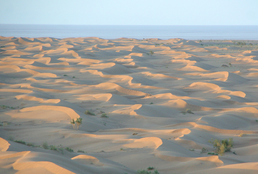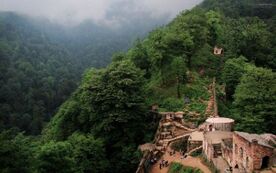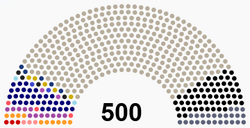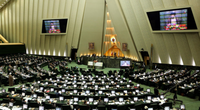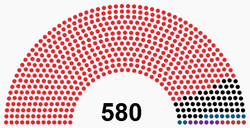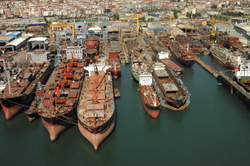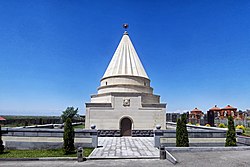Union of Zorasani Irfanic Republics
This article is incomplete because it is pending further input from participants, or it is a work-in-progress by one author. Please comment on this article's talk page to share your input, comments and questions. Note: To contribute to this article, you may need to seek help from the author(s) of this page. |
Union of Zorasani Irfanic Republics اتحاد جماهیراسلامی آسیای Ettehād-ye Jamaheer-ye Erfāni-ye Zorasāni اتحاد الجمهوريات الإسلامية الآسيوية al-Ittiḥād al-Jumhūrīat al-Erfānīyah al-Korsāniyy | |
|---|---|
| Motto: استقلال، آزادی، جمهوری اسلامی Esteqlāl, Āzādi, Ettehād اتِّحاد حُرّيّة اسْتِقْلال Istiqlāl, Ḥurriyya, Ittiḥād (Independence, Freedom, Union) | |
Anthem:
| |
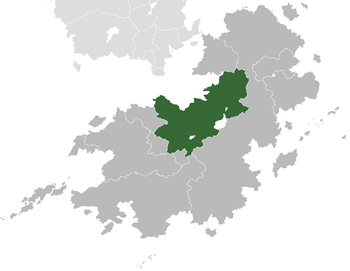 Zorasan in green, Coius in dark-grey. | |
| Capital and largest city | Zahedan |
| Official languages | Arabic Pardarian |
| Ethnic groups | See Ethnicity |
| Demonym(s) | Nautasian |
| Government | Federal sattarist parliamentary republic |
| Mahrdad Ali Sattari | |
| Evren Volkan | |
| Farzad Akbari | |
| Ibrahim Al-Fahim | |
| Legislature | Supreme Assembly |
| Superior Council | |
| Popular Council | |
| Establishment | |
| 31 October 1953 | |
• Constitution adopted | 4 November 1953 |
• Treaty of Unification | 22 May 1956 |
| 1974-1979 | |
| 6 April 1979 | |
• Current constitution | 10 May 1984 |
| Area | |
• Total | 963,827 km2 (372,136 sq mi) |
• Water (%) | 1.3% |
| Population | |
• 2018 estimate | 173,112,587 |
• 2012 census | 171,998,206 |
• Density | 179.60/km2 (465.2/sq mi) |
| GDP (PPP) | estimate |
• Total | $2.077 trillion |
• Per capita | $12,002.59 |
| GDP (nominal) | estimate |
• Total | $1.290 trillion |
• Per capita | $7,455 |
| Gini | 46.9 high |
| HDI | 0.769 high |
| Currency | Toman (₮) |
| Date format | dd.mm.yyyy |
| Driving side | left |
The Union of Zorasani Irfanic Repulics (Pasdani: اتحاد جماهیراسلامی آسیای; Ettehād-ye Jamaheer-ye Erfāni-ye Zorasāni; Arabic: اتحاد الجمهوريات الإسلامية الآسيوية; al-Ittiḥād al-Jumhūrīat al-Erfānīyah al-Korsāniyy), commonly called the Zorasani Union, Zorasan or the UZIR, is a federal non-partisan parliamentary republic located in northern Coius. The UZIR is bordered by Xiaodong and Negara to the south, Tsabara to the east and the Solarian Sea to the north and Mazdan Sea to the north-west. The UZIR is home to diverse ethnic groups, with Arta Irfan as the majority and XXX as the largest minority, it also includes XX, Yazidis, XX and a tiny minority of Abburites. Its two largest ethnic groups are Pardarians and Arabs. With a population of 173.1 million it is the Xth largest country in the world and and Xth largest in Coius, it has a total area of 963,827 km2 (372,136 sq mi), making it the Xth largest in Coius and the Xth largest in the world.
History...
The UZIR is a member of the Community of Nations, GIFA, NAC and the ITO and is recognised as a regional to middle power by international commentators; some have claimed that it is a potential superpower in the event of further economic development. The UNIR has the largest proven oil reserves and is the world's largest producer of oil and natural gas, leading it to be considered an energy superpower.
History
Pre-history
Sorsanid Empire (350 BCE-300 CE)
Arasanid Empire (300-720)
Rise of Irfan (720-890)
Heavenly Dominions (890-1100)
Gorsanid Empire (1100-1700)
Gorsanid collapse (1700-1880)
Colonial Zorasan (1880-1946)
Independence and revolution (1946-1950)
- Independence re-secured following the Solarian War.
- Unification of Pardaran in late 1946 under a de-facto restored monarchy.
- Instability over the government system results in the overthrow of the monarchy in a legalistic coup in 1948.
- Republic announced.
- Further political instability and emergence of far-left and traditionalist-religious movements.
- Arduous Revolution led by Mahrdad Ali Sattari in 1949 and creation of single-party Sattarist state.
- Revolution spreads to neighbouring Khazestan, overthrowing the Arab monarch.
- merge of Pardaran and Khazestan into the Union of Khazestan-Pardaran.
Union of Zorasani States (1950-1979)
- Zorasani Crisis, UKP seeks to export the revolution to neighbouring states.
- Samrin and Aramand brought into the UKP through revolution and coup respectively in late 1950.
- UKP becomes UZS.
- Emergence of a cold war between northern Arab states.
- Clashes and provoked crises in Ninevah and Riyada see overthrow of governments in 1953 and 1954, they're absorbed into UZS
- UZS-Arab War (1955-1957) sees the collapse of Suraq and defeat of Irvadistan.
- UZS becomes dominant power in northern Coius.
- Ali Sattari and government focus on rebuilding and development.
- 1962-1970 continued sporadic clashes between UZS and Irvadistan, backed by Tsabara.
- 1971 - Battle of the Gholdan Pass with Negara.
- 1971 - Ali Sattari dies
- Succeeded by Ghassan Ali Ghaddar
- 1972-75 - tensions with Irvadistan worsen
- 1975 - Irvadistan War erupts with Irvadi invasion of Suraq.
- 1976 - Operation Golden Dawn results in counter-invasion of Irvadistan
- 1977 - Irvadistan holds to a stalemate, mutual use of chemical weapons and missiles
- 1977 - Ali Ghaddar removed and succeeded by Javan Jahandar
- 1978 - Operation Prophet's Fury results in Irvadi military collapse
- 1979 - Irvadi government surrenders and country is annexed into the UZS.
- 1979 - UZIR formed.
Union of Zorasani Irfanic Republics (1979-present)
Geography
The land area of Zorasan is XX square miles (XX km2). Pardaran is the largest state at XXXX square miles (XXXX km2). Aramand, is the smallest at is XXXXX square miles (XXX km2) in area. In Irvadistan the Ruqqad Highlands; which is home to Irvadistan's highest point, Mount Hajar Asud (2,814 m; 9,232 ft), divide the western coastal plain from the al-Ramal al-Wusta Desert, while directly south, the Khazi coast is divided from the Dasht-e-Aftab by the Yafā'Aswad highlands. The Dasht-e-Aftab covers roughly 36% of the Khazi-Pardarian central region. The Tinnin Plateau divides the Aftab from the northern Pardarian coastline, these mountains also aided the creation of the Aftab, by blocking oceaniac rain-clouds from heading southward. The Pasdani south is one of the world's most mountainous regions, its landscape dominated by rugged mountain ranges that separate various basins or plateaux from one another. The south-west is dominated by the Exri and Soban; the last contains Zorasan's highest point, Mount Fereydun at 5,610 m (18,406 ft). To the south of the north-west and the Aftab are highlands that protect the southern plains from the desert and arid north. The southern Pasdani region varies between open flat plains to rolling yet fertile hills and valleys.
Irvadistan's interior is arid desert, but is punctuated by two fertile zones, from the north to south runs the Khabur and from the north to the east runs the Khanzir, these two rivers are vital for the country's agricultural regions and are the primary locations of the population. Both stripes of fertile ground are flanked by arid desert.
The UZIR, with its large size and geographic variety, includes most climate types. Having 11 climates out of the world's 13, Zorasan's climate is diverse, ranging from arid or semiarid, to subtropical along the Pardarian coast and the southern forests. On the southern edge of the country, on the shores of Lake Sharezan (the Sharezan Plain) temperatures rarely fall below freezing and the area remains humid for the rest of the year. Summer temperatures rarely exceed 29 °C (84.2 °F). Annual precipitation is 680 mm (26.8 in) in the eastern part of the plain and more than 1,700 mm (66.9 in) in the western part. Water Scarcity is considered to be the biggest threat to Pardaran, Khazestan and Ninejah and Zorasan at large.
To the west, settlements in the Soban basin experience lower temperatures, severe winters with below zero average daily temperatures and heavy snowfall. The eastern and central basins are arid, with less than 200 mm (7.9 in) of rain, and have occasional deserts. Average summer temperatures rarely exceed 38 °C (100.4 °F). The coastal plains of Irvadistan in south-western Pardaran have mild winters, and very humid and hot summers. The annual precipitation ranges from 135 to 355 mm (5.3 to 14.0 in).
Government and politics
Zorasan is a federal, Sattarist, parliamentary republic. Zorasan’s political system operates under a framework laid out in the 1983 constitution known as the Treaty of Ascension (Ertegha-Peyman). Amendments generally require a two-thirds majority of both the Popular Council and the Superior Council; the fundamental principles of the constitution, as expressed in the articles guaranteeing human dignity, the role of Irfan, the federal structure, and the rule of law are valid in perpetuity.
The Rayis Jomhur-katee (state president), Evren Volkan (19 March 2015–present), is the head of state and invested primarily with representative responsibilities and powers. He is elected by the Superior Council as one of two candidates presented by the Popular Council. The second-highest official in the Zorasani order of precedence is the Avval A’Zam (First Minister), the head of government, who is appointed by the Rayis-Jomhur-katee after being elected by the Popular Council. The third-highest ranking official is the Rayisol-Vozara (President of the Council), who is elected by the Popular Council and responsible for overseeing the daily sessions of the body.
The First Minister, Farzad Akbari (20 March 2015–present), is the head of government and exercises executive power through their State Council, similar to the role of a Prime Minister in other parliamentary democracies. Federal legislative power is vested in the parliament consisting of the Majlis-Mee (Popular Council) and Majlis-Ala (Superior Council) , which together form the legislative body. The Majlis-Mee is elected through direct elections, by first-past-the-post. The members of the Majlis-Ala are divided between those who represent the governments of seven federated states, elected through direct elections by first-past-the-post and those (two-thirds majority), who are appointed by the military.
Since 1983, the entire political system of Zorasani has been constitutionally mandated as non-partisan, with no formal political party, movement or club being permitted to exist within the federal, state or local levels of government. However, the federal level does see several informal blocs or groupings of politicians. The three most prominent blocs are the Zorasani Alliance of the Great Journey, the League of Revolutionary Pioneers and the Civic and Just Association.
Government
Zorasan's three branches of government are poorly defined by the Constitution. The State President, who appoints the First Minister, is elected by the Superior Council. The First Minister is appointed by the State President after receiving the confidence of the Popular Council through an open-ballot election. The head of the Supreme Judicial Council is appointed by the Popular Council with the backing of the Joint Commission for Political Stability.
The relationship between the State President and the First Minister is often disputed. According to convention the State President plays a mostly ceremonial role outside of appointing the First Minister, coordinating between the federal and state governments, acting as commander-in-chief of the armed forces and representing the Union in diplomatic affairs. The State President is elected in an direct election by the Superior Council. Meanwhile the First Minister officially acts as the head of government appointing and leading the executive (the State Council of Ministers) which heads several government departments. Whilst the First Minister is appointed by the State President, they must commanded the confidence of the Popular Council. Whilst the Constitution implies that the First Ministers' power outstrips that of the State President, a capable State President with greater influence over individual parliamentarians may allow the State President to exercise power and influence over the First Minister. Since 1998, the State President has been allowed to sit on cabinet meetings and request roles and duties outside of the constitution from the First Minister.
As of 2015, the Union has been governed by two members of the Zorasani Alliance for the Great Journey, with Evren Volkan as State President and Farzad Akbari as First Minister. It has been known that both worked jointly in 2015 to secure their respective positions, and share power.
The government is also believed to be beholden to the military and clergy, due to the two cabinet-level positions of First and Second State Councillor, with one of each going to the military and clergy. The State Councillors are appointed by the Joint Commission for Political Stability and act as mediators and overseers for the JCPS and government. The military is also guaranteed three positions within the cabinet, Minister of National Defence, Minister of National Security and the Minister of Media and Information.
Legislature
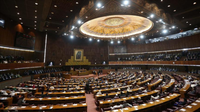 |
|
Zorasani Alliance for the Great Journey (18) League of Revolutionary Pioneers (9) Civic and Just Association (5) United Irfanic Coalition (4) Independents (72) |
The legislature of Zorasan, known as the Popular and National Council, is a bicameral body, and is comprised of a 108-member Superior Council (upper house) and a 580-member Popular Council (lower house), the Popular Council is the sovereign national body. Members of the Popular Council are elected through the first-past-the-post system under universal adult suffrage, representing electoral districts known as Popular constituencies, all members serve for four-year terms. All candidates are vetted by the Joint Commission for Political Stability, a body comprised of senior figures from the military and clergy.
The Superior Council has one-third (36 members) elected from the seven constituent states and two union territories (each providing 4 members), the remaining 72 are appointed by the National Commission for Governance and Unity, a military run-body. The official role of the Superior Council is to equalise the power and representation of the seven states and ensure that all legislation works for the benefit of all states of the union.
A third body, though not constitutionally recognised as part of the legislature is the National Arbitration Council which is comprised of six jurists and seven military officers (nominally the most senior in the union). The Council interprets the constitution and may veto the Parliament. If a law is deemed incompatible with the constitution or Esafkar (Irfanic law), it is referred back to the Parliament for revision.
The legislature of the union is unique in that both houses are formally non-partisan. Though informal groupings of politicians do exist, none operate a structure, organising document or official leadership. These groupings often take shape as like-minded politicians voting in the same manner, while they lack any formal or organised structure, these groupings do vote as cohesive blocs and pursue set agendas. In order to avert de-facto partisanship, First Ministers are prohibited from having ministers drawn from one exclusive bloc by the constitution, as a result, most union governments take the form of coalition governments.
The history and nature of the blocs has been fluid since 1979. On average most blocs last only two consecutive terms of parliament, before either being dissolved or merged into another. However, since 2005, the current make up of the parliament has been solid, making the incumbent blocs the oldest in union history. The largest bloc is the Zorasani Alliance for the Great Journey, which is a hardline conservative Sattarist group, with extensive ties to the military. It has been the "bloc of power" since 2005, with two-consecutive state presidents and first ministers coming from the bloc. The second largest is the League of Revolutionary Pioneers, also comprised of hardliners, it often backs the NAGJ. The third largest is the Civic and Just Association, which is generally considered reformist and liberal in nature.
Law
Administrative divisions
The Union comprises seven federal states which are collectively referred to Eyalat (states). Each state has its own state constitution, and is largely autonomous in regard to its internal organisation. Two of the states are city-states consisting of just one city: the holy cities of Namin and Ardakan. The union also consists of two Union Territories (Ettehād-ye Azaree), which are governed directly by the federal government, these include the Shidvar Islands and Darvazeh. Each state and union territory is led by an elected governor (ostāndār), who is appointed by the state's legislature.
Despite the differences in size and population of the states, each is divided in 24 provinces (ostān), there are 168 provinces in the Union. The provinces are divided into counties (šahrestān), and subdivided into districts (baxš) and sub-districts (dehestān).
Foreign policy
The official goal of the government of Zorosan is to establish a new world order based on world peace, global collective security, and international equality. Since the time of the Irvadistan War, Zorasan's foreign relations have often been portrayed as being based on four strategic principles; eliminating outside influences in the immediate region, maintaining Zorasan as the leading power of northern Coius, securing Zorasani unification and pursuing extensive diplomatic contacts with developing and non-aligned countries, primarily in wider Coius-Bahia.
Zorasan is a member of the Community of Nations, GIFA, NAC and the ITO.
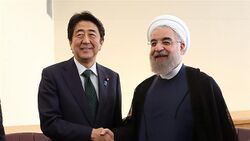
Zorasan's closest relations are with Xiaodong, although the nature of these close relations differ. In regards to Xiaodong, following the Corrective Revolution when XXX met Mahrdad Ali Sattari in 1957 both countries began to foster close political and economic ties as both countries were ruled by one-party governments intent on regional hegemony. Close cooperation between both governments became more prominent under Sun Yuting and Ghassan Ali Ghaddar, and have since Evren Volkan and Yuan Xiannian held office seen a dramatic revival of ties. The government of Xi Yao-tong has furthered this policy, signing significant trade deals with Zorasan in 2016 and 2017, and an increase in military cooperation. Zorasan meanwhile has provided military and technological cooperation with Xiaodong, most prominently during the Third Duljunese-Xiaodongese War. The extremely close and friendly relations between Xiaodong and Zorasan has been called the Rongzhuo-Zahedan Axis.
Armed Forces
The Irfanic Revolutionary Army (Arteš-e Enghelâb-e Erfāni) consists of the Land Forces, the Navy and the Air Force. The fifth branch exists, which is held by the National Protection Force which exists as a mostly paramilitary force. The Irfanic Revolutionary Army currently has around 3,712,000 troops overall (761,000 active, 2,951,000 in reserve, including 367,664 paramilitary soldiers), making it overall the Xth largest in the world
The State President of the Union is the commander-in-chief of the Irfanic Revolutionary Army, which answers to the State Council of Ministers via Ministry of National Defence (MoND), which is headed always, by the Chief of Staff of the Irfanic Revolutionary Army. Military affairs are primarily handled by the Supreme National Security Commission, a forum of military commanders who nominally subordinate to the State Council of Ministers. Since the Arduous Revolution, the military has played a significant and domineering role in national politics.
The coast guard and gendarmerie and police forces take on military functions - in the event of war, but are subordinate to the Ministry of State Security. The main intelligence unit, the General Intelligence Directorate (Resat-e Ejmal-e Ettela'at; RESAT), also is officially part of the military structure however they report directly to the government via the Ministry of National Defence. Despite its role as the military intelligence agency, it enjoys a significantly greater role in federal intelligence activities than the State Security Service (Ta'min-e Ejbaree-e Dowlat; TEJDO).

The Irfanic Revolutionary Army has gone through numerous periods of modernisation and reform to maintain a dominant position within northern Coius; known as the Union First (Ebteda'Ettehād) policy, allowing it remain relatively as the most disciplined, well armed and capable forces in Coius; this has meant either great efforts being made in domestic R&D or the purchase of quality equipment and systems from foreign producers.
It is widely accepted that Zorasan operates an extensive chemical weapons arsenal, with an estimated combined total of over 14,000 tons of chemical agents in storage.
Conscription - known as "Patriotic and Revolutionary Duty" (Takleef Enghelabee-parast) is currently enforced for all male citizens between the ages of 18-21 for a period of a year to three years, dependent on education and job location. Zorasan does not recognise conscientious objection and does not offer a civilian alternative to military service, many conscientious objectors are either imprisoned under charges of "conspiring against the state" or press-ganged into four year service.
The armed forces are subject to controversial accusations of abuse and harsh treatment of trainee soldiers; with the use of beatings, caning and lashing in punishment of poor behaviour, low enthusiasm and slow progress in improvements. The IRA is also known to train its forces in "Isolated Desert Deployment"; in that units of troops are airdropped into the desert, with limited food and water to develop resilience in the event of being trapped or stranded in hostile environments seen in Coius.
Human rights
Zorasan has been consistently criticised internally and abroad, with human right monitoring organisations such as the International Council for Democracy as of 2017 ranking the Union as unfree. The ICD stated "Zorasan remains a fundamentally flawed parliamentary democracy, with overbearing control by the unaccountable and unelected clergy and military controlled bodies. The mass surveillance and censorship system remains in place and undermines freedom of speech and the press. The excessive use of capital punishment, torture, rape and false imprisonment also remains rampant."
Zorasan's situation is unique in that the systematic abuses of human rights is conducted outside government control and oversight. The ICD has noted that much of the repressive policies and activities are conducted by the military, rather than the federal government. The military's oversized control of state media and the use of the General Intelligence Directorate (RESAT) to pursue activists, civil rights lawyers and critics of the state, led the ICD and the Euclean Community in 2018 to note, "without confrontation of the deep-state within the UZIR, it is unlikely that human rights will improve in the medium to long term."
Economy
Zorasan's economy is a mixture of state ownership of oil and other large enterprises, village agriculture, and small to medium-scale private trading and service ventures. In 2017, GDP was $1.290 trillion ($2.077 trillion trillion at PPP), or $12,002 at PPP per capita. Zorasan is the Xth largest economy in Coius and XXth in the world. Zorasan is ranked as an upper-middle income economy by the Global Institute for Fiscal Affairs. In the early 21st century the service sector contributed the largest percentage of the GDP, followed by industry (mining and manufacturing) and agriculture.
The Central Bank of the Union is responsible for developing and maintaining the Zorasani toman, which serves as the country's currency. The government doesn't recognize trade unions other than those under the Labour Union of Workers and Farmers, which are subject to the approval of employers and the military. The minimum wage as of August 2017 was 2,331 toman a month ($434). Unemployment as of August 2017 was 5.45%, youth unemployment stands at 10.5%, aided by the Bandegee-ye Ashkhas (People's Service) a government run, but charity funded employment scheme that offers young people short-term contracted work.
In 2017, about 45% of the government's budget came from oil and natural gas revenues, and 31% came from taxes and fees. As of 2017 it is estimated, oil and natural gas contributed 30% whilst taxes and fees increased to 45%; as the federal government maintained its policies of diversification of the economy. Since 1980, Zorasan has operated the economic policy known as "Oil to Factory", in that oil revenues would be used as capital to fund industrialisation and diversification, over an extensive welfare state.

The Union's economy has consistently registered growth since 1979, due to its persistent economic reform plan in operation since 1980, which aims to completely diversify the economy from over-reliance on petrochemicals, whilst at the same time greatly expanding the sector's production capacity. As a result, Zorasan maintains a strong biotechnology, nanotechnology, and pharmaceuticals industry, as well as a manufacturing economy leading in the fields of car-manufacture and transportation, construction materials, home appliances, food and agricultural goods, armaments, pharmaceuticals, information technology, power and petrochemicals. Zorasan has a sizeable automotive industry, which produced over a million and a half motor vehicles in 2017, ranking as the fourth largest producer in Coius. Shipyards have 15 floating docks of different sizes and two dry docks. In 2017, there were ten active shipyards in Zorasan, with another 50 being built at the start of 2018. Zorasani shipyards are highly regarded both for the production of chemical and oil tankers up to 10,000 dwt and also for their mega yachts. National brands like Tava and Varan are among the largest producers of consumer electronics and home appliances in Coius and invest a substantial amount of funds for research and development in new technologies related to these fields.
Other key sectors of the national economy are Irfanic banking, construction, home appliances, electronics, textiles, food, mining, iron and steel, and machine industry. As of 2018, the agricultural sector accounted for 11 percent of GDP, while the industrial sector accounted for 25 percent and the services sector for 62 percent. However, agriculture still accounts for a quarter of employment.
Energy
Zorasan has the largest proved gas reserves in the world, with 38.6 trillion cubic metres, and is the largest gas producer. It also ranks first in oil reserves with an estimated 313,600,000,000 barrels. Many consider Zorasan to be the premier energy superpower, unlike other oil producers in Coius and elsewhere, Zorasan does not import fuel products due to high regulation on use and tough laws regarding contraband. Since the 1980s, the UNIR has used the high energy prices to fund exploration of other untapped fields and the modernisation of old production facilities.
The addition of new hydroelectric stations and the streamlining of conventional coal and oil-fired stations increased installed capacity to 33,000 megawatts. Of that amount, about 75% was based on natural gas, 18% on oil, and 7% on hydroelectric power. In 2017, Zorasan announced plans to construct a further eight large solar and wind farms in its desert regions, to decrease its carbon footprint, while two tidal power plants are also to be built. Zorasan also announced plans to construct two major damns on the Khazehabad and Azani Rivers in Pardaran.
Manufacturing
Zorasan has maintained manufacturing as one of the biggest recipients of oil revenues through the process known as "Oil to Factory"; which began under State President Javad Jahandar in 1980. The country's continued use of the Oil to Factory scheme has seen greater investment and returns, due to the high levels of oil and gas production. However, the official position was declared early to be focusing on "high-tech industries", in a move towards an electronic and IT based industrial sector.
Zorasan's major manufactured products are petrochemicals, steel and copper products. Other important manufactures include automobiles, home and electric appliances, telecommunications equipment, cement and industrial machinery. Zorasan operates the largest operational population of industrial robots in northern Coius. Other products include paper, rubber products, processed foods, leather products and pharmaceuticals. In 2017, textile mills, using domestic cotton and wool such as Zahedan Patou and Borazjan Termeh employed around 570,000 people around Borazjan, Zahedan, Qufeira and along the Golden coast. Zorasan remains one of the largest producers of heavy vehicles, including trucks, buses, construction vehicles and locomotives that are sold to Coian markets mostly.
In 2016, the government announced an extension to the Oil to Factory programme, which will see government grants and subsidies focus on the expansion of high quality products including computers, smartphones and other information technology.
Agriculture
As of August 2017, Zorasan is the world's largest producer of hazelnuts, cherries, figs, apricots, quinces and pomegranates; the second largest producer of watermelons, cucumbers and chickpeas; the third largest producer of tomatoes, eggplants, green peppers, lentils and pistachios; the fourth largest producer of onions and olives and the fifth largest producer of sugar beet. The country has been self-sufficient in food production since 1984.
Tourism
Science and technology
Infrastructure
Demographics
According to the Statistical Centre of the Union (Markaz-e Amar-e Ettehād), the country's population was 171.9 million people in 2012, nearly 70% of whom lived in towns and cities. According to the 2018 estimate, the population is increasing by 1.55 percent each year. Zorasan has an average population density of XX people per km². People within the 15–64 age group constitute 67.4 percent of the total population; the 0–14 age group corresponds to 25.3 percent; while senior citizens aged 65 years or older make up 7.3 percent. In 1980, when the first official census was recorded in the Union (following the annexation of Irvadistan), the population was 63.6 million. The largest city in the union, Zahedan, is also Xth largest in population and size in Coius.
Article 18 of the Union Constitution defines a "Zorasani" as "anyone who is bound to the Zorasani union-state through the bond of citizenship"; therefore, the legal use of the term "Zorasani" as a citizen of the Union is different from the ethnic definition. However, the majority of the Zorasani population are of Pardarian ethnicity and approximately 55-60 per cent of the country's citizens identify themselves as Pardarian. It is estimated that there are at least 17 ethnic groups represented in Zorasan.
Reliable data on the ethnic mix of the population is not available, because federal census figures do not include statistics on ethnicity. Arabs are the largest non-Pardarian ethnicity at anywhere from 25-29 per cent of the population, Turkics are also included. Statisticians have been known to use pre-1979 studies, finding that in 1928, Pardarians represented 48% of the population, while Arabs formed 35%, alongside 10% for the Turkics. In a 2013 study, Bahram Azidi wrote, "it is more likely that the Pardarians collectively form 53% of the national population, Arabs standing at 41% and various minorities standing at 6%. More often than not, many reject ideas of ethnicity in support of the state's aims of unifying all Zorasani peoples as one harmonious group."
There remains in Zorasan, some significant "Non-Irfanic" minorities, including Yazidis, Kurds, Balochs, Pashtun and Tajiks.
The term "minority" itself remains a sensitive issue in Zorasan, while the federal government is frequently criticised for its treatment of minorities. Although minorities are not recognised, state-run Tasnim Broadcasting broadcasts television and radio programs in minority languages. Also, some minority language classes can be chosen in elementary schools.
| Rank | Province | Pop. | Rank | Province | Pop. | ||||
|---|---|---|---|---|---|---|---|---|---|
 Zahedan  Javanrud |
1 | Zahedan | Zahedan-takht | 18,557,230 | 11 | Ardakan | Aqda | 970,611 |  Faidah Mazdavand |
| 2 | Javanrud | Ejrud | 9,573,217 | 12 | Gamsar | Shahrud | 803,852 | ||
| 3 | Faidah | Qarqur | 4,932,075 | 13 | Shul Abad | Delfan | 776,802 | ||
| 4 | Mazdavand | Daland | 3,403,919 | 14 | Tarim | Hajjah | 543,127 | ||
| 5 | Bandar-e Parvadeh | Bushkan | 3,157,120 | 15 | Oshtorinan | Basht | 541,111 | ||
| 6 | Narmashir | Ganaveh | 2,110,343 | 16 | Pataveh | Ashkezar | 490,536 | ||
| 7 | Khalifan | Zabdah | 2,501,332 | 17 | Qush Teppa | Teppah | 436,002 | ||
| 8 | Borazjan | Ashkezar | 1,855,375 | 18 | Bandar-e-Khamir | Dorestan | 399,110 | ||
| 9 | Qeydar | Tarut | 1,813,997 | 19 | At-Turbah | Khamr | 300,019 | ||
| 10 | Qufeira | Raydah | 1,711,000 | 20 | Namin | Tazeh-Kand | 274,358 | ||
Languages
Religion
Historically, Proto-Pardarian religion and the subsequent Zoroastrianism faith was the dominant religion in the Khazi-Pardaran region, while pre-Irfanic polytheism dominated Irvadistan. This changed after the Irfanic conquest of all three countries. Since the 900s CE, Pardaran and Khazistan have been dominated by the Asha sect of Irfan, while Irvadistan saw the emergence of Hasawi Irfan in the 1100s, this sect represents a significant minority of the state. Other faiths such as Zoroastrianism and Yazdânism exist in smaller communities across the country.
Officially the union is "Irfanic" with both Asha and Hasawi being recognised as the state religions, sectarianism against either sect is severely punished and unconstitutional, but no such status exists for the minority religions.
Today, the Asha remains the majority religion of the population, with 91,702,269 adherents which stands as 81.72% of the population. 17.01% of the population are Hasawi Irfanics, with 19,093,508 adherents. Yazdânism stands at 0.67% with 757,592 adherents, Zoroastrianism follows at 0.41% with 460,055 adherents and Yazidism is the smallest with 0.19% of the population and 213,196 adherents.
Yazdânism, Zoroastrianism and Yazidism are officially recognized by the government. But the Bahá'í Faith, which has several thousand adherents along the border with Siphria, is not officially recognized, and has been persecuted during its existence in both Khazistan and Pardaran since the 19th century, this was extended to the federal government upon its creation.
Healthcare
The Zorasani public health system, the Unified Health System (Beham Behbood Nezam), is managed and provided by all levels of government, being one of the largest system of this type in the world. On the other hand, private healthcare systems play a complementary role.
Public health services are universal and offered to all citizens of the country for free. However, the construction and maintenance of health centers and hospitals are financed by taxes, and the country spends about 9% of its GDP on expenditures in the area. In 2012, Zorasan had 1.85 doctors and 2.3 hospital beds for every 1,000 inhabitants.
Despite all the progress made since the creation of the universal health care system in 1988, there are still several public health problems in Zorasan. In 2006, the main points to be solved were the high infant (2.51%) and maternal mortality rates (73.1 deaths per 1000 births). However, since 2015 significant progress has been made in combating infant mortality, reducing it from 2.51% to 1.98%.
The number of deaths from noncommunicable diseases, such as cardiovascular diseases (151.7 deaths per 100,000 inhabitants) and cancer (72.7 deaths per 100,000 inhabitants), also has a considerable impact on the health of the Nautasian population. Finally, external but preventable factors such as car accidents, violence and suicide caused 10.9% of all deaths in the country.
Education
Responsibility for educational supervision in the union is primarily organised within the individual federal states. The adult literacy rated 94.0% in September 2015, while it had rated 85.0% in 2008, up from 31.5% in 1976.
The requirement to enter into higher education is to have a high school diploma and pass the Federal University Entrance Exam (officially known as konkur (کنکور)). Many students do a 1–2 year course of pre-university (piš-dānešgāh), which is the equivalent of the International Baccalaureate. The completion of the pre-university course earns students the Pre-University Certificate.
Zorasan's higher education is sanctioned by different levels of diplomas, including an associate degree (kārdāni; also known as fowq e diplom) delivered in two years, a bachelor's degree (kāršenāsi; also known as lisāns) delivered in four years, and a master's degree (kāršenāsi e aršad) delivered in two years, after which another exam allows the candidate to pursue a doctoral program (PhD; known as doktorā).
A system of apprenticeship called Dual Learning (Tāšnieh Blāmooz) leads to a skilled qualification which is almost comparable to an academic degree. It allows students in vocational training to learn in a company as well as in a state-run trade school. This has been widely credited for aiding the country's diversification of its economy away from reliance upon petrochemicals, it remains the only Nautasian country to operate the system.
According to some university rankings, the top university in the UNIR is the Rasool Burzafrah Academy, followed by Mahrdad Ali Sattari University and Zahedan Metropolitan University, Mazdavand Technical University and the Central Ekanbat University. However since the 1960s, many military academies have offered their student cadets non-military courses, in the sciences, engineering, mathematics and later IT.


